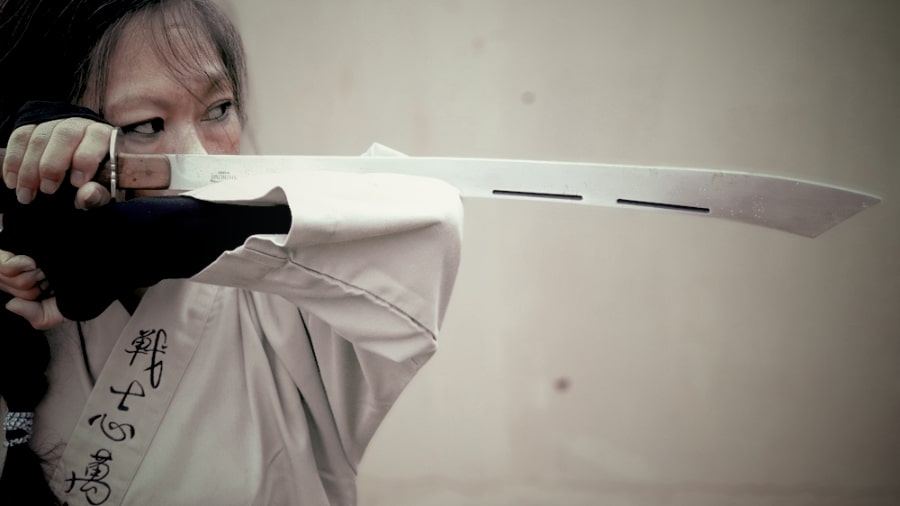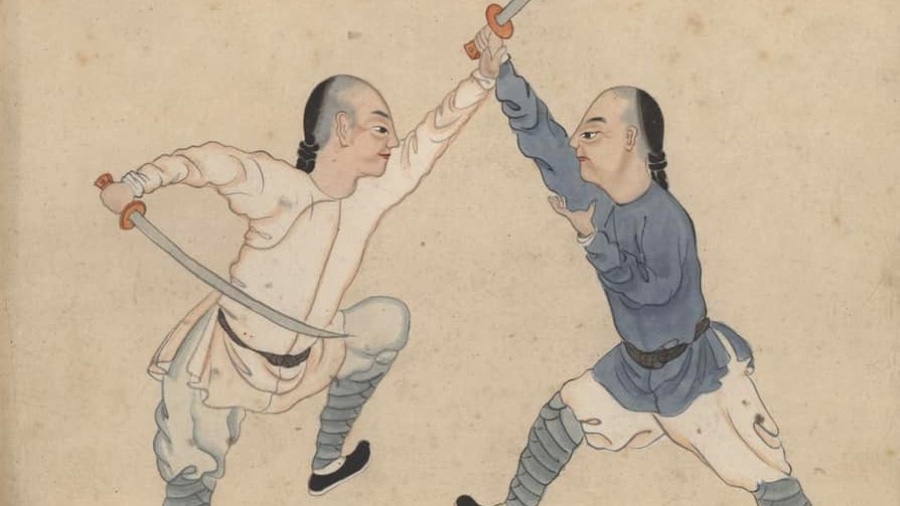
Noelle Conn (黃少娟) with the Demon Head Sword 鬼頭刀 (c.2020)
Overview
The old way 古道 of martial arts 武術 is deeply intertwined with traditional values and philosophy, viewing martial skill as more than mere combat techniques – it is a discipline aimed at the cultivation of mind, body, and spirit. In ancient practices, wu shu 武術 (mo sut in Cantonese) was inseparable from its cultural roots, rooted in self-cultivation and a respectful alignment with nature, society, and one’s own potential.
The old way 古道 values harmony with the world, restraint, and humility. In ancient China, martial artists were seen as protectors who wielded strength tempered by wisdom, as opposed to mere fighters. Adhering to the old way 古道 required that practitioners see combat skills as only a small part of their training. Mastery also demanded the development of virtues such as patience, loyalty, and a sense of duty towards one’s community. Even the movements themselves were imbued with philosophical significance, often mirroring aspects of the natural world or embodying principles found in Daoism, Confucianism, and Buddhism. For instance, the concept of yin 陰 and yang 陽 influenced everything from stances to strategy, teaching practitioners to balance aggression with stillness, action with awareness.
For those who followed this path, wu shu 武術 was a lifelong journey, where training in techniques went hand-in-hand with learning how to maintain one’s integrity and clarity. It was this balance that was believed to produce a true martial artist, who could serve not only as a warrior but as a moral example and a protector of peace.
Definitions are Important
The term ‘old way’ (gudao 古道) in the context of martial arts carries profound etymological roots that reflect an emphasis on tradition, virtue, and harmony within martial practice. Breaking down the characters, we find the following:
- 古 (gu) – This character means ‘ancient’ or ‘old,’ symbolising an enduring respect for the practices, philosophies, and customs of the past. In ancient Chinese culture, this idea of gu 古 invokes not only antiquity but a sense of wisdom accumulated through centuries. It reflects practices that have withstood the test of time, suggesting that the knowledge embedded in the ‘old way’ is not easily abandoned and is worth preserving.
- 道 (dao) – Often translated as ‘way’ or ‘path,’ dao 道 holds a complex meaning rooted in Daoist philosophy. In Daoism, dao 道 represents the universal order or natural flow, an ideal way of existing in harmony with the cosmos. In martial arts, dao 道 conveys more than a physical path; it implies a journey of alignment with the world, where skill in combat is only a part of a larger, spiritual pursuit. This character embodies a holistic vision that views martial arts not merely as technical skills but as a way of life in harmony with both self and nature.
When combined in gudao 古道, the term signifies a path that honours ancient principles, traditions, and ways of thinking. The old way is not a static relic but a living, breathing discipline that teaches students to respect both the past and the natural order. It suggests that to study martial arts in the old way is to undertake a journey that intertwines personal development with an understanding of the underlying harmony of the universe.
In martial arts – wu shu 武術 – these two elements signify a methodology that is guided not by brute strength, but by a refined wisdom and a code of conduct that aligns with age-old ethical values. Wu 武, denoting martial skill, and shu 術 , meaning skill or art, are directed by gudao 古道. Together, these elements underline that true mastery includes embodying virtues of restraint, respect, and humility, honouring the past and ensuring that every action reflects the ancient wisdom of the ‘Way.’
Western Concepts
Modern Western martial arts, often rooted in competitive sports like mixed martial arts (MMA), boxing, or sport jiu-jitsu, contrast sharply with the traditional concept of the old way 古道 in Chinese martial arts. While Western approaches typically focus on physical prowess, measurable skills, and performance in competition, the old way 古道 of martial arts 武術 emphasises a holistic integration of body, mind, and spirit, with a deeper cultural, ethical, and philosophical foundation.

A Qing 清 era painting outlines the absolute nature of combat in ancient times.
Ancient Combat
The old way 古道 of wu shu 武術 , or specifically martial combat in this case, in ancient times was a far cry from the controlled environment of modern ring fighting. In ancient China, combat was a life-or-death affair, grounded in practical warfare and survival. Martial artists trained for real-world engagements where the stakes were not merely personal glory or accolades, but the preservation of life, family, or community. Outcomes were decided in an instant through blades, mace weapons, or poisons.
Weapons and Strategy in Ancient Wu Shu 武術
Weapons were a fundamental component of ancient wu shu 武術 , ranging from common battlefield tools to concealed weapons suited for clandestine operations. Strategies were crafted based on awareness, adaptability, and an understanding of both open and concealed tactics. Combatants utilised the terrain to their advantage, employing elements of surprise, concealment, and deception. In the world of yin fa 隱法, the ‘art of hiding or concealment,’ practitioners learned to merge with shadows, strike without being seen, and escape without a trace – skills essential for night operations and stealth. Strategies were not bound by rules but were based on the principles of yin 陰 and yang 陽, allowing the practitioner to harmonise with their surroundings and exploit the opponent’s weaknesses.
Comparison to Modern Ring Fighting
In contrast, modern ring fighting in martial arts is conducted within a controlled environment, with rules, weight classes, and referees to ensure safety. Victory is achieved by points, knockouts, or submissions, with a strong focus on sportsmanship and unarmed technical skill. While ring fighting requires immense physical conditioning and skill, it generally does not account for the unpredictability and lethality of ancient combat scenarios.
The techniques used in ring fighting, while effective within the confines of the ring, are often honed for sport rather than survival. Fighters are trained to anticipate a regulated set of moves and tactics from their opponents, a stark contrast to the unpredictable, weapon-laden encounters of ancient wu shu 武術. The psychological and strategic aspects of ancient martial arts – such as weapon versatility, ambush tactics, and the balance of life and death – find little place in modern sports, where the focus is on endurance and technique rather than survival and decisive action.
The ‘Kung Fu’ Problem
Though all Chinese martial arts were once the ‘old way’ 古道 of martial arts 武術, they are certainly not so today. Much of the modern Chinese martial arts or ‘kung fu’ world has devolved into a commercialised mess or exercise-based practice, with other forms mangled by time and the influence of Western boxing. Such schools or teachers should not be confused with a school like Warrior Heart 戰士心門, which continues to train with real weapons and cultivate authentic skills rooted in history and tradition.
Authors Note:
Ring fighting ‘martial arts,’ modern styles, and any other definition that may come to mind are fundamentally different from practicing an ancient ‘military art of war’, which is what Chinese martial arts are supposed to be. A practitioner of any gudao wushu 古道武術 style will destroy a modern, unarmed opponent within seconds. Blades, for instance, wielded by a trained warrior in any gudao wushu 古道武術 style, would quickly annihilate a modern ‘martial artist.’ This is why the practitioner of gudao wushu 古道武術 pursues the ‘Art’ approach: it is easy to kill or break an opponent. So once that is learnt, we spend a lifetime trying to master oneself and one’s approach to life and love.
